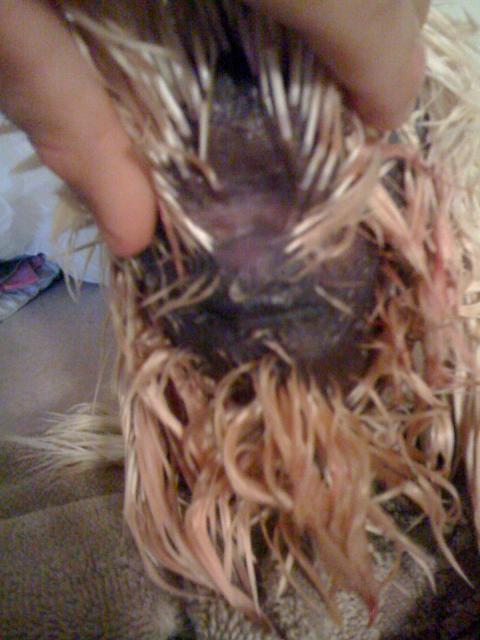Well, this was not something i expected to deal with on this chicken- the other I have is the only with history of prolapse.
I went to check the coop for the evening, and found my little year old(ish) frizzled Silkie hen with prolapse. One egg was hanging all the way out of her body, trapped in what I believe is inside out oviduct. I soaked her, but she was in more and more pain so went in and repositioned the egg and finally got it out without tearing more than a tiny bit of the membrane. The actual vent opening was up top and to the left, with the prolapsed tissue hanging all the way out, so I kind of maneuvered the egg sideways and helped her push it out. Imagine my surprise when the first egg to come out is shell-less, followed by an enormous, hard egg. Got them both out, the protruding matter was about the size of a quarter, and deep, dark red. There were a few blood clots that came off in the bath. I cleaned her up, slathered her backside with honey, and pushed the prolapse back in. It is staying in, other than the top of the vent pooching out like a lower lip. She's constantly pushing, so the vent is going kind of in and out, but the prolapse is inside.
I love this hen. She is my only frizzled Silkie, she has no history of anything bad, egg related. She has access to free choice oyster shell, and she is healthy. I'm very nervous that there could be some sort of internal damage, given that in the worst of the egg pushing, part of the vent kept poofing up with air and then going back down.
I've read every prolapse thread on here, but I'm still panicking. She's cleaned, the vent looks ok and has the honey. I am going to put her in the sick crate (large dog crate) on newspaper, darken the cage, and just offer her a tiny bit of food along with oyster shell and some boiled egg. What else do I need to be doing? I would very much appreciate help with this one, she is so special for me.
Here is the vent after getting the eggs out- she was in too much pain and panic beforehand for me to get pics of the eggs hanging, but picture a full sized egg covered in bloody red membrane hanging entirely outside of her body, with another harder egg behind her.


Here are the two eggs- one shellless membrane, one rock hard egg with sandpaper like texture. The shellless egg was out first, followed by the hard one. At first I did not even know there were two eggs. It's insane- I have never seen or heard of this with two eggs at once.

I went to check the coop for the evening, and found my little year old(ish) frizzled Silkie hen with prolapse. One egg was hanging all the way out of her body, trapped in what I believe is inside out oviduct. I soaked her, but she was in more and more pain so went in and repositioned the egg and finally got it out without tearing more than a tiny bit of the membrane. The actual vent opening was up top and to the left, with the prolapsed tissue hanging all the way out, so I kind of maneuvered the egg sideways and helped her push it out. Imagine my surprise when the first egg to come out is shell-less, followed by an enormous, hard egg. Got them both out, the protruding matter was about the size of a quarter, and deep, dark red. There were a few blood clots that came off in the bath. I cleaned her up, slathered her backside with honey, and pushed the prolapse back in. It is staying in, other than the top of the vent pooching out like a lower lip. She's constantly pushing, so the vent is going kind of in and out, but the prolapse is inside.
I love this hen. She is my only frizzled Silkie, she has no history of anything bad, egg related. She has access to free choice oyster shell, and she is healthy. I'm very nervous that there could be some sort of internal damage, given that in the worst of the egg pushing, part of the vent kept poofing up with air and then going back down.
I've read every prolapse thread on here, but I'm still panicking. She's cleaned, the vent looks ok and has the honey. I am going to put her in the sick crate (large dog crate) on newspaper, darken the cage, and just offer her a tiny bit of food along with oyster shell and some boiled egg. What else do I need to be doing? I would very much appreciate help with this one, she is so special for me.
Here is the vent after getting the eggs out- she was in too much pain and panic beforehand for me to get pics of the eggs hanging, but picture a full sized egg covered in bloody red membrane hanging entirely outside of her body, with another harder egg behind her.


Here are the two eggs- one shellless membrane, one rock hard egg with sandpaper like texture. The shellless egg was out first, followed by the hard one. At first I did not even know there were two eggs. It's insane- I have never seen or heard of this with two eggs at once.

Last edited:


